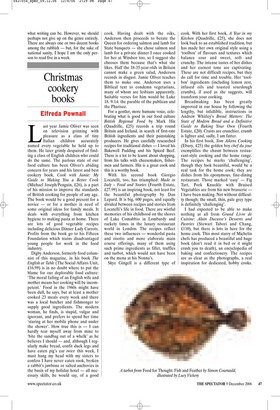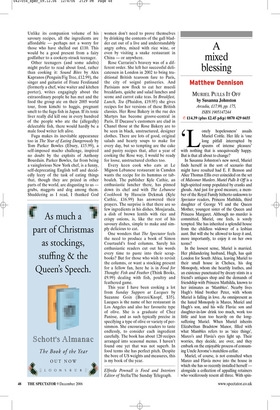Christmas cookery books
Elfreda Pownall
Last year Jamie Oliver was seen on television grinning with pleasure as a class of tiny Italian children accurately named every vegetable he held up to them. He later grimly despaired of finding a class of English children who could do the same. The parlous state of our food culture has been Oliver’s abiding concern for years and his latest and best cookery book, Cook with Jamie: My Guide to Making You a Better Cook (Michael Joseph/Penguin, £26), is a part of his mission to improve the standards of British cooking for people of any age. The book would be a good present for a novice — or for a mother in need of some original ideas for family meals. It deals with everything from kitchen hygiene to making pasta at home. There are lots of good vegetable recipes including delicious Dinner Lady Carrots. Profits from the book go to his Fifteen Foundation which trains disadvantaged young people for work in the food industry.
Digby Anderson, formerly food columnist of this magazine, in his book The English at Table (The Social Affairs Unit, £16.99) is in no doubt where to put the blame for our deplorable food culture: ‘The moral failing of an English wife and mother means her cooking will be incompetent.’ Food in the 1960s might have been dull, he says, but at least a mother cooked 23 meals every week and there was a local butcher and fishmonger to supply good ingredients. The modern woman, he finds, is stupid, vulgar and ignorant, and prefers to spend her time ‘staring at her mobile phone and under the shower’. How true this is — I can hardly tear myself away from mine to ‘bite the sandbag out of a whelk’ as he believes I should — and, although I regularly make bread, confit duck legs and have eaten pig’s ear twice this week, I must hang my head with my sisters to confess I have never eaten rook, broken a rabbit’s jawbone or salted anchovies in the basin of my holiday hotel — all necessary skills, he would say, of a good cook. Having dealt with the oiks, Anderson then proceeds to berate the Queen for ordering salmon and lamb for State banquets — she chose salmon and lamb for a private dinner I once cooked for her at Windsor too, so I suggest she chooses them because that’s what she likes. Half the 18-35-year-olds in Britain cannot make a green salad, Anderson records in disgust. Jamie Oliver teaches them to make one. Anderson uses a Biblical text to condemn vegetarians, many of whom are lesbians apparently. Suitable verses for him would be Luke 18. 9-14: the parable of the publican and the Pharisee.
For a gentler, more humane voice, celebrating what is good in our food culture British Regional Food by Mark Hix (Quadrille, £25) records a trip round Britain and Ireland, in search of first-rate British ingredients and their painstaking producers. He gives carefully researched recipes for traditional dishes — I loved his Bakewell Pudding and his Spiced Beef. There is a lot to be learnt about shopping, from his talks with cheesemakers, fishermen and farmers. Hix is a great cook and this is a worthy book.
With his second book Giorgio Locatelli, too, has triumphed: Made in Italy – Food and Stories (Fourth Estate, £27.99) is an inspiring book, not least for the beautiful photography by Dan Lepard. It is big, 600 pages, and equally divided between recipes and stories from Locatelli’s life in food. There are wistful memories of his childhood on the shores of Lake Comabbio in Lombardy and rackety times in the luxury restaurant world in London. The recipes reflect these two influences — wonderful pasta and risotto and more elaborate main course offerings, many of them using such prime ingredients as fillet, truffles and turbot, which would not have been on the menu at his Nonna’s.
Skye Gingell is a different type of cook. With her first book, A Year in my Kitchen (Quadrille, £25), she does not look back to an established tradition, but has made her own original style using a ‘toolbox’ of flavours and textures which balance sour and sweet, soft and crunchy. The intense tastes of her dishes and her earnest tone are captivating. These are not difficult recipes, but they do call for time and trouble. Her ‘toolbox’ ingredients (including lemon zest, infused oils and toasted sourdough crumbs), if used as she suggests, will transform your cooking.
Breadmaking has been greatly improved in our house by following the lengthy, but infallible, instructions in Andrew Whitley’s Bread Matters: The State of Modern Bread and a Definitive Guide to Baking Your Own (Fourth Estate, £20). Crusts are crunchier, crumb is lighter and, sadly, I am fatter.
In his first book, Tom Aikens Cooking (Ebury, £25) the golden boy chef du jour exemplifies the chasm between restaurant-style cooking and the home range. The recipes he marks ‘challenging’, though they look beautiful, would be a real task for the home cook; they are dishes from his eponymous, fine-dining restaurant. Those marked ‘easy’ — Fig Tart, Pork Knuckle with Braised Vegetables are from his new brasserie I have been making. Not without difficulty though; the small, thin, pale grey type is definitely ‘challenging’.
I had expected to be able to make nothing at all from Grand Livre de Cuisine: Alain Ducasse’s Desserts and Pastries (Stewart Tabori and Chang, £110), but there is lots in here for the home cook. This most starry of Michelin chefs has produced a beautiful and huge book (don’t read it in bed or it might crush you to death), an encyclopedia of baking and confectionery. The recipes are as clear as the photographs, a real inspiration for dedicated, hobby cooks. Unlike its companion volume of his savoury recipes, all the ingredients are affordable — perhaps not a worry for those who have shelled out £110. This would be a good present from a fairy godfather to a cookery-struck teenager.
Other teenagers (and some adults) might prefer to read about food, rather than cooking it: Sound Bites by Alex Kapranos (Penguin/Fig Tree, £12.99), the singer and guitarist of Franz Ferdinand (formerly a chef, wine waiter and kitchen porter), writes engagingly about the extraordinary people he has met and the food the group ate on their 2005 world tour, from kimchi to haggis, pregnant smelt to the fugu fish in Japan. If its toxic liver really did kill one in every hundred of the people who ate the (allegedly) delectable fish, there would hardly be a male food writer left alive.
Fugu makes its inevitable appearance too in The Year of Eating Dangerously by Tom Parker Bowles (Ebury, £15.99), a self-imposed macho challenge, inspired no doubt by the exploits of Anthony Bourdain. Parker Bowles, far from being a vainglorious New York chef, is a funny, self-deprecating English toff and decidedly leery of the task of eating things that, though they are prized in other parts of the world, are disgusting to us grubs, maggots and dog among them. Shuddering as I read, I thanked God women don’t need to prove themselves by drinking the contents of the gall bladder cut out of a live and understandably angry cobra, mixed with rice wine, or even by visiting a snake restaurant in China — or anywhere.
Rose Carrarini’s bravery was of a different order. She left her successful delicatessen in London in 2002 to bring traditional British tearoom fare to Paris, the city of soigné patisseries. And Parisians now flock to eat her muesli breakfasts, quiche and salad lunches and scone and carrot cake teas. In Breakfast, Lunch, Tea (Phaidon, £19.95) she gives recipes for her versions of these British classics. Her Rose Bakery in the rue des Martyrs has become groove-central in Paris. If Ducasse’s customers are clad in Chanel those at the Rose Bakery are to be seen in black, unstructured, designer clothes. There are lots of good, original salads and hearty soups to make for every day, but so tempting are the cake and pastry recipes that, after a year of cooking the Rose way, I would be ready for loose, unstructured clothes too.
Every keen cook who eats at Le Mignon Lebanese restaurant in Camden wants the recipe for its hummus or tabbouleh. The publisher Kyle Cathie, an enthusiastic luncher there, has pinned down its chef and with The Lebanese Cookbook by Hussein Dekmak (Kyle Cathie, £16.99) has answered their prayers. The surprise is that there are so few ingredients in his dishes. Moujarada, a dish of brown lentils with rice and crispy onions, is, like the rest of his savoury dishes, simple to make and simply delicious to eat.
One wonders that The Spectator feels the need to produce a book of Simon Courtauld’s food columns. Surely his enthusiastic readers cut out his words every time to paste into their scrapbooks? But for those who wish to revisit the columns, or want a stocking present for a fellow fan, here he is in Food for Thought: Fish and Feather (Think Books, £9.99) dealing with fish, poultry and feathered game.
This year I have been cooking a lot from Sunday Suppers at Lucques by Suzanne Goin (Borzoi/Knopf, $35). Lucques is the name of her restaurant in Los Angeles and also her favourite type of olive. She is a graduate of Chez Panisse, and as such typically precise in specifying a type of olive or variety of persimmon. She encourages readers to taste endlessly, to consider each ingredient carefully. The book has about 120 recipes arranged into seasonal menus. I haven’t found one yet that was not superb. In food terms she has perfect pitch. Despite the bore of US weights and measures, this is my book of the year.
Elfreda Pownall is Food and Interiors Editor of Stella/The Sunday Telegraph.



























































































 Previous page
Previous page